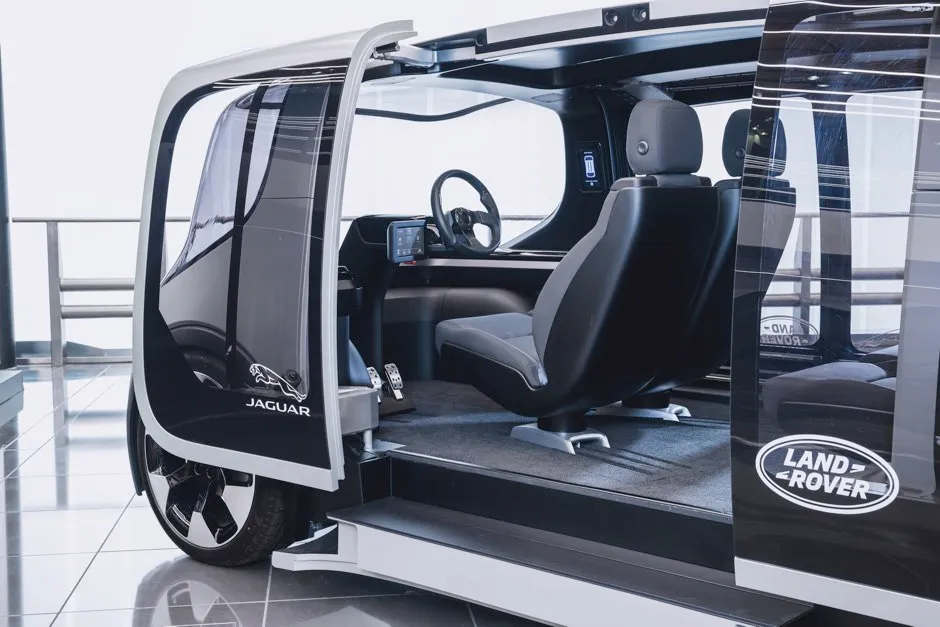- Driverless concept car begins trials at Warwick University.
- Jaguar Land Rover's six-seater pod has a top speed of 30mph.
- Comes under JLR’s Destination Zero mission: zero carbon, zero accidents and zero congestion.
Jaguar Land Rover (JLR) has started trialling Project Vector, a new autonomous shuttle service that will ferry students around Warwick University’s campus. The company plans to take them as far as Coventry city centre by 2021.
It is a glimpse of where Jaguar Land Rover, and other car manufacturers, think the future of urban motoring is going.
The vehicle uses a skateboard chassis – a simple four-metre-long platform with wheels – that can be configured to support different bodies, powered by an electric motor.
For now, the car is a six-seater pod, with a top speed of 30mph and a driver at the wheel to help out in the early stages. But the body could be swapped out altogether, to become an inner-city delivery vehicle.

Most concept cars rarely make it to the real world, but Project Vector promises to make a big impact on the self-driving car landscape. For the most part, autonomous cars have become pretty good at learning to drive. But in the future car companies, like JLR, anticipate that as well as not wanting to drive, many people won’t want to own a car either.
Urban populations may come to rely on fleets of driverless cars ferrying them around city centres instead. If that happens, the most popular services will be the ones that get us from A to B most efficiently.
For this to work, these fleets of self-driving cars will need software that has learned to anticipate demand (like when’s there’s a football game), avoid traffic, and know where and when to recharge its battery.
It's the next phase of learning that needs to happen if autonomous cars are to make our lives better, not worse. Especially if you don’t want to have the cars unintentionally making congestion worse as they coast around town looking for a fare or somewhere to park.
Read more about driverless cars:
- What you need to know before you get in a driverless car
- Five innovative vehicles delivering the future of transportation
- How could self-driving cars change motoring?
This is all part of JLR’s Destination Zero mission: zero carbon, zero accidents and zero congestion. It’s a lofty mission from a company that makes big SUVs, but Jaguar has been heavily investing in electric car tech, even setting up its own single series motorsport around the I-Pace.
And as bans on new petrol and diesel cars come into effect across Europe at earlier and earlier dates, this just seems like judicious planning by the UK’s biggest car company.

JLR isn’t the only one to trial this approach to an autonomous fleet. Earlier this year, General Motors unveiled the Cruise Origin, an autonomous “people mover” that’ll carry people around cities, only this car has no steering wheel or pedals, meaning it’ll need special exemptions from local governments to begin testing.
Meanwhile, last October in London, a more familiar-looking Ford Mondeo fitted with autonomous tech began feeling out the capital’s roads. The trial was carried out by a UK tech firm called Oxbotica and was the first of its kind.
This summer the company hopes it can begin a trial of a ride-sharing taxi service together with the cab company Addison Lee. Who wants a go?
Reader Q&A: Would it be possible for driverless cars to use echolocation?
Asked by: Rhys Abul, Southampton
Sending out sound waves and listening for their echo is a great way to detect obstacles in water – submarines can detect objects many kilometres away. But sound doesn’t travel nearly so well in air. Bats can only detect objects up to 20 metres away, falling to around two metres in poor conditions.
Light is less affected by atmospheric conditions, which is why self-driving cars use LIDAR (‘light detection and ranging’), bouncing infrared laser light off objects in order to detect them.
Read more:
